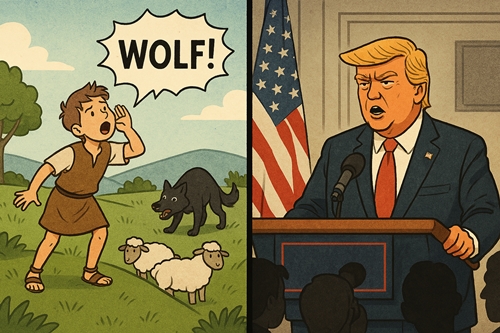In Aesop’s timeless fable, a boy repeatedly tricks villagers into thinking a wolf is near. When danger finally strikes, no one listens—his cries fall flat against the weight of past deception. Today, we live in a digital echo chamber where falsehoods travel faster than facts, and trust is worn thin. In this age of viral rumors and strategic deceit, combating disinformation narratives isn’t just about calling out the wolves. It’s about rebuilding the very voice that warns us.
Today, the stakes are far higher than sheep.
A Culture of Lying: From the White House to the Public Square
Misinformation, or lying, became routine from the earliest days of Trump’s presidencies. Fact-checkers documented over 30,000 false or misleading statements during his first term alone. I don’t even want to think how many times he’s lied this term! His lies aren’t just a political tool; they represent a governing strategy. Cabinet heads and surrogates echo and amplify these lies and distortions, creating a feedback loop of confusion and distrust.
The following are just a few recent examples:

Climate Change Denial
- Trump falsely claimed that sea levels will rise only one-eighth of an inch over 500 years, contradicting decades of scientific consensus.
- He called climate change “one of the greatest scams of all time” after Hurricane Helene devastated the Southeast.
- He mocked the term “global warming,” falsely asserting scientists abandoned it because “some places are cooling”.
- He claimed rising seas would create “more oceanfront property”, a grotesque distortion of the threat to coastal communities.
The One Big Beautiful Bill (OBBB)
- Trump repeatedly claimed the bill eliminates taxes on Social Security, a lie echoed by the Social Security Administration in a mass email.
- In reality, the bill provides a temporary tax credit for seniors, but does not change how Social Security is taxed.
- The bill slashes Medicaid and SNAP funding, despite Trump’s claim that “your Medicaid is left alone”.
- It’s projected to add $3.4 trillion to the deficit over the next decade.
Immigration Targeting
- During the campaign, Trump and VP candidate J.D. Vance falsely claimed Haitian migrants in Ohio were eating pets—a baseless rumor that spread like wildfire.
- His administration has ramped up masked raids, detentions without warrants, and threats of mass deportation—even of legal immigrants.
The Consequences: A Nation Unmoored
When lies become policy, truth becomes optional. Americans are left asking: What’s real? What’s propaganda?
This erosion of trust is catastrophic:
- It weakens democratic institutions.
- It polarizes communities.
- It leaves people vulnerable to manipulation.

Like the villagers in the fable, we risk ignoring real threats because we’ve been lied to too many times. Disinformation narratives overwhelm us.
How We Fight Back
Fact-Check Relentlessly
| Tool | Description |
|---|---|
| PolitiFact | Rates political claims on a “Truth-O-Meter” |
| FactCheck.org | Nonpartisan analysis of political statements |
| Snopes | Debunks viral rumors and hoaxes |
| CheckForFacts | Automated claim verification with citations |
| Google Fact Check Explorer | Aggregates fact-checks from multiple sources |
Build Media Literacy Strategies
Teach yourself and others to spot emotional manipulation and clickbait. Emotional manipulation is a tactic used to control or influence others by exploiting their feelings. It’s often subtle.
Clickbait is content designed to grab attention and drive clicks—often through sensationalized or misleading headlines. It exploits curiosity, emotion, or urgency, but rarely delivers on its promise.
| Emotional Manipulation Tactics | Clickbait Tactics |
|---|---|
| ⋄ Gaslighting: Twisting facts to make you doubt your memory or perception. ⋄ Guilt-tripping: Making you feel responsible for someone else’s emotions or actions. ⋄ Over-the-top flattery or love-bombing: Used to gain trust quickly, then control. ⋄ Playing the victim: Shifting blame and avoiding accountability. ⋄ Dismissive language: “You’re overreacting” or “You’re too sensitive” to invalidate concerns. | ⋄ Vague headlines: “You won’t believe what happened next…” ⋄ Exaggerated claims: “This one trick will change everything!” ⋄ Emotional triggers: Anger, shock, or awe to provoke a reaction. |
These tactics are common in political messaging, especially when leaders want to deflect criticism or rally support through fear or false narratives.
Other ways to build media literacy are to:
- Verify sources before sharing.
- Understand bias and framing.
Speak Truth Loudly
- Challenge disinformation narratives circulating among your friends and coworkers. Don’t let misinformation go unchallenged.
- Share verified facts. If you know the truth, get it out there. Correct false facts with the truth.
- Support independent media. Independent media might not be too sexy, but it’s reliable and worth supporting.
- Amplify truth-tellers and watchdogs. Be free in sharing where truthful information can be found.
Back to the Fable
The boy lost his sheep because he abused the truth. Today, we risk losing far more – our democracy, our shared reality, our ability to act collectively.
But unlike the villagers, we don’t have to walk away. We can choose to listen, verify, and respond.
Misinformation isn’t just a national crisis. It’s a local one. Every neighborhood, school board, town meeting, and online group is affected by the fog of falsehood. But the antidote begins with everyday people who choose clarity over chaos. If national lies feel overwhelming, this is your call to action: Start local. Speak truth. Build resilience.
